On a recent visit to Brooklyn, NY to celebrate with my son and his newly pregnant wife, I remembered seeing Cobble Hill Health Center on my last visit in his neighborhood. It sits on a quaint street just blocks from the Brooklyn Bridge Park. I had walked past and wondered what lay within the nicely manicured entrance of the red brick building where several folks in wheelchairs sat outside.
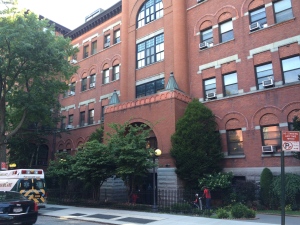
Having seen the movie, “Alive Inside”, I thought that name was the place where Henry “came alive” while listening to music on an iPod for the first time. So I reviewed the movie on Netflix and got the name of the Activity Coordinator featured and gave her a call at work. She was there and we set up an appointment to meet that afternoon.
Taking my film producer/photographer son along (just in case), we waited in the lobby for Yvonne Flunory. She has been an Activity Coordinator at Cobble Hill Health Center for sixteen years. She loves her work and makes it a family affair. She proudly explained that her daughter comes as a junior volunteer. Under the leadership of Louise Dueno, the Director of Therapeutic Recreation, along with two other Activity Coordinators, Cheryl McNeill and Renée Adamson, they offer the activities for all 364 residents. Forty beds are in the dementia unit. They were all gracious enough to wait around after a long day to talk with me and my son for an hour. When sharing the bond of dementia care, there is so much to learn, so much to talk about, yet the subjects extended beyond what I expected.
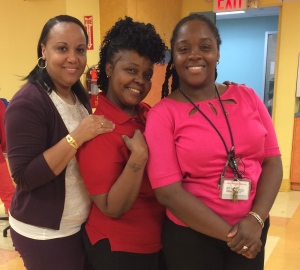
I wanted to know how the release of the movie “Alive Inside” had affected them. But first, I met Louise Dueno. She warmly received us in her office and told us of her family connections of caring for her father who had vascular dementia, what it was like for her as she shared the care with her sister, and how he ultimately died. Then she described the difficulties she had caring for her uncle and how he became a resident at Cobble Hill Health Center. So her professional life blurs into personal enabling her to understand what families are dealing with. She related an experience she had just that day that gave her some relief that she had made a good decision about placing him in someone else’s care. She understood why I would take the time from a vacation to stop in and talk to her about caring for a loved one with dementia.
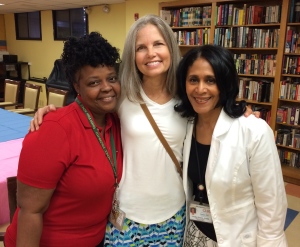
Ms. Dueno told me about the The Alzheimer’s Association, New York City Chapter’s Palliative Care for Advanced Dementia: Training and Implementation, called “Comfort First” being developed in their facility with a grant coordinated by Ann Wyatt from the Alzheimer’s Association. We talked about the Music and Memory Program that became popular after the release of the movie “Alive Inside” which offers certification that Cobble Hill Health Center has. That means that upon the initial assessment of a new resident, music preferences are examined either from information from family members, popular music from their era, and other background information. She also mentioned how Wisconsin is implementing this program in 250 long-term care facilities, replacing antipsychotic drugs with music for managing behavioral symptoms. She showed me her collection of iPods being charged in her office, her stash of replaceable sponge headset covers, and her two laptops that they use with their residents. We agreed that the direct listening of ones’ favorite music was more effective than a group activity of listening to music as it shuts out all the other noises and distractions.
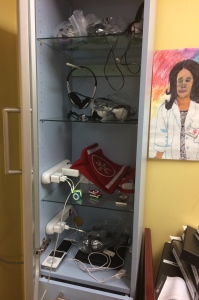
While we talked, another woman waited patiently to speak to us. Turns out, she had some information she wanted to share. For six years, Ammeka Berken has coördinated and initiated volunteer programs with New York Cares, a not-for-profit program that is a clearing house for volunteers in New York. Since my son lives near Cobble Hill Health Center, she invited him to their recurring programs at the Center: Friday they take up to ten residents down to the Brooklyn Bridge Park; Saturday is Swing night which is a dance for the residents; then on Thursday evenings they take residents down to hear the live music at the park. She took the opportunity to spread her mission by including us.
Passion is what drives those who believe in what they are doing. Whether it is Dan Cohen with his development of the Music and Memory Program, or initiating the “Comfort First” program in residential facilities, or matching volunteers with life changing opportunities, or implementing activities to residents in long-term care facilities, or caring for a loved one, we move by a force beyond our own strength and abilities. The wish to enrich life for another human drives us to do, to pursue, to create, to learn, and encourage others to do the same. It was a delight to meet these passionate people.
Our encounter built a bridge from Mobile, Alabama to Cobble Hill, NY. May we learn from our connection and strengthen the resolve to improve the care for people with dementia.






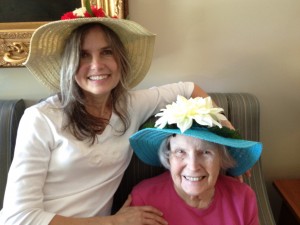

Recent Comments